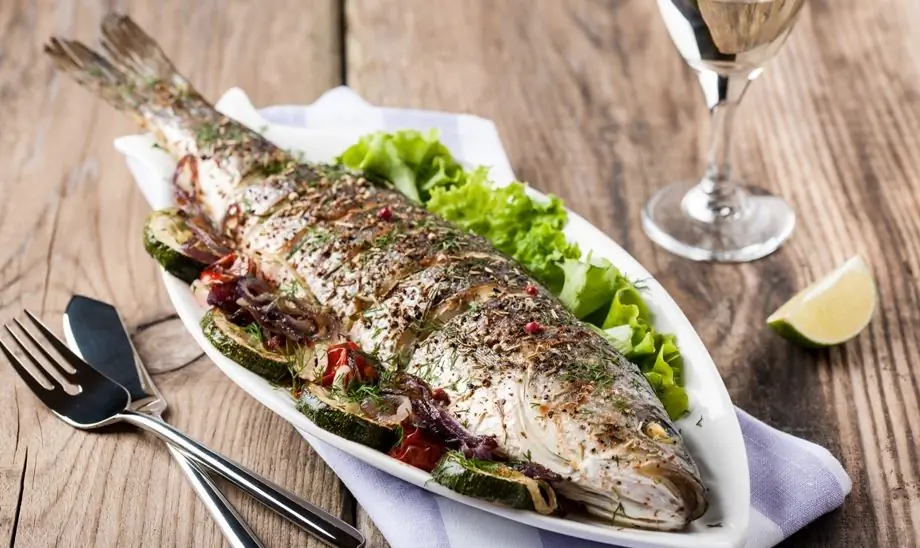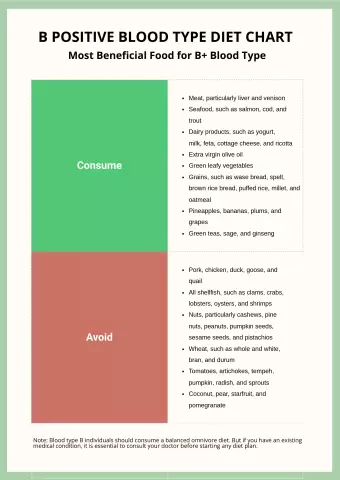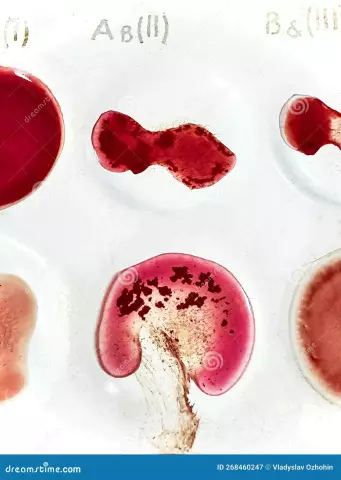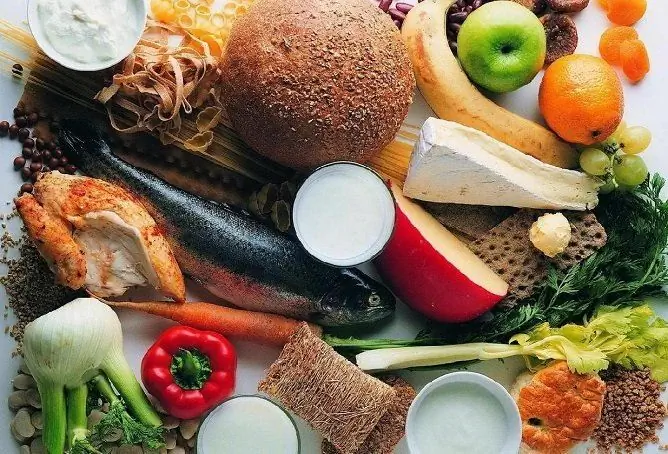- Author Rachel Wainwright [email protected].
- Public 2023-12-15 07:39.
- Last modified 2025-11-02 20:14.
Diet for 1 blood group
People with 1 blood group in this system are called "Hunters". It is argued that this group arose earlier than others, during a period when hunting was the main method of obtaining food.
Hunters have strong immunity and an actively working digestive tract, but such people do not tolerate experiments with nutrition. They are encouraged to eat more protein foods and cut back on carbohydrates.
The main problem of people with blood group 1 is a low metabolic rate, which contributes to weight gain, so when losing weight, you need to make every effort to "accelerate" it. If the goal of the diet is to lose weight, it is necessary to exclude from the diet: most legumes, since they block the production of insulin; cabbage and oats - they slightly reduce the production of thyroid hormones. Increasing the amount of seafood, greens, algae, and iodized salt consumed stimulates the production of thyroid hormones. Red meat and liver also increase metabolic rate.
Diet rules for blood group 1:
- seafood is good to eat with algae, as they contain a lot of iodine;
- take vitamin and mineral preparations, which contain vitamins of groups B and K, calcium, manganese and iodine;
- accompany the diet with high-intensity physical activity. A suitable option is skiing, swimming, aerobics, or running.

Advantages of the blood group 1 diet
The diet provides a general recovery of the body, normalization of metabolic processes. A large amount of protein in the diet contributes to the loss of fat mass, and not muscle.
A wide range of products allows you to create a menu in accordance with individual preferences, the absence of strict restrictions on the amount of food - to avoid the painful feeling of hunger, which reduces the likelihood of a breakdown.
Disadvantages and contraindications of the diet for 1 blood group
The absence of a rigid menu can lead to the appearance, and then an increase in the number of violations of the diet, over time - to its termination. Composing a balanced menu requires a thoughtful and responsible approach, although this process becomes much easier once you have gained experience.
The diet is strictly contraindicated in people with kidney disease and thyroid dysfunction.
People with chronic medical conditions should consult a doctor before starting a diet.
What foods are allowed?
List of approved products:
- meat: lamb, beef, veal, venison, buffalo meat;
- offal: heart, liver;
- fish: pike, cod, mackerel, herring, sturgeon, salmon, sole, swordfish, bluefish, halibut, perch, hake, sardine;
- vegetables: artichoke, sweet potato, Jerusalem artichoke, broccoli, kohlrabi, hot peppers, leafy vegetables, white, yellow, Spanish onions, leeks, Swiss chard, parsnips, parsley, horseradish, garlic;
- fruits: figs, plums, prunes;
- rye bread in small quantities;
- walnuts, pumpkin seeds;
- spices: ginger, cayenne pepper, turmeric, curry;
- olive oil;
- juices: carrot, plum, cherry, pineapple;
- herbal teas from mint, linden, dandelion, fenugreek, mulberry, hops, rose hips;
- soda drinks.
Neutral products:
- meat: rabbit, chicken, turkey, partridge, quail, pheasant, duck;
- eggs;
- fish and seafood: beluga, anchovies, flounder, carp, smelt, sea bass, haddock, eel, mussels, squid, crabs, crayfish, oysters, shrimps, scallops, veners;
- dairy products: homemade cheese made from cow, sheep and goat milk, mozzarella, feta, feta cheese;
- fats and oils: butter, sunflower, soybean oil;
- soy milk, tofu;
- pine nuts, almonds, hazelnuts, pecans, sesame seeds, sunflower seeds, chestnuts;
- legumes: green peas, green beans, white and lima beans, red soybeans, red and black beans, chickpeas;
- vegetables: rutabaga, daikon, yellow and green peppers, jalapenos, watercress, shallots, olives, cucumbers, radishes, celery, tomatoes, pumpkin, zucchini;
- mushrooms;
- fruits and berries: apricots, nectarines, peaches, watermelons, pineapples, bananas, strawberries, cherries, grapes (and in the form of raisins), pomegranates, grapefruits, pears, apples, melons, kiwi, raspberries, currants, cranberries, lemons, limes, mango, papaya, dates, persimmon;
- cereals: buckwheat, rice, barley, spelled (spelled), wheat, rice, soy, whole grain bread;
- juices: apricot, birch, pomegranate, grapefruit, cranberry, carrot, cucumber, celery, tomato;
- spices: basil, anise, bergamot, mustard, cloves, allspice, cardamom, bay leaf, coriander, marjoram, paprika, caraway seeds, thyme, savory, sage, saffron, tarragon;
- honey, chocolate, maple syrup;
- seasonings: mustard, mayonnaise, soy sauce;
- herbal teas from hawthorn, valerian, verbena, birch buds, elderberry, ginseng, oak bark, catnip, yarrow, chamomile;
- other drinks: green tea, natural grape wine, beer.
What foods are prohibited?
- meat: pork, goose;
- fish and seafood: sea pike, catfish, octopus, caviar, any smoked and salted fish;
- dairy products: yogurt, kefir, buttermilk, cow and goat milk, hard cheese, processed cheese, whey;
- oils and fats: peanut, cottonseed, corn oil;
- vegetables: Peking cabbage, cauliflower, white cabbage, avocado, eggplant, potatoes, olives, rhubarb;
- fruits: oranges, tangerines, blackberries, strawberries, coconuts;
- cereals: corn, oats, wheat, rye, flour products, especially baked goods;
- poppy seeds, cashews, pistachios, peanuts;
- legumes: beans (except white, green and lima), lentils;
- industrial sauces and marinades;
- orange, apple, cabbage juices;
- condiments: all kinds of vinegar, vanilla, cinnamon, nutmeg, white and black pepper;
- herbal teas from St. John's wort, senna, gentian, red clover, corn stigmas, burdock, coltsfoot, shepherd's purse, echinacea:
- other drinks: apple cider, spirits, coffee, black tea.
Those who follow a diet for weight loss should give up sugar, any citrus fruits and legumes.
Diet menu for blood group 1
Approximate diet menu for 1 blood group for 2 days:
Breakfast: salad of pear, banana, red apple and grapes.
Second breakfast: a slice of rye bread with red pepper lecho.
Lunch: trout baked with vegetables, green tea.
Afternoon snack: a handful of walnuts.
Dinner: seaweed and shrimp salad.
Breakfast: rye bread with a slice of meat, mint tea.
Second breakfast: any fruit of your choice.
Lunch: beef chops, baked vegetables.
Afternoon snack: vegetable salad with herbs.
Dinner: fish cakes, ginger tea.
Useful Tips
Tip 1: if the excess weight is significant, the basis of the menu should be fresh vegetables and boiled or baked meat, the amount of fruits and nuts should be reduced.
Tip 2: it is recommended in the first few weeks of the diet to calculate the daily calorie content of the menu, making sure that it is in the range of 1500-1800 kcal - this range is optimal for safe weight loss.
| Diet characteristic | final grade |
| Duration: unlimited |
3.5 out of 5 The diet for blood group 1 is predominantly protein, although small amounts of carbohydrates are allowed. For weight loss, foods are introduced into the diet that stimulate the production of thyroid hormones. |
| Recommended frequency: not determined | |
| Weight loss rate: | |
| Safety: | |
| Variety of products: |
YouTube video related to the article:
Found a mistake in the text? Select it and press Ctrl + Enter.






